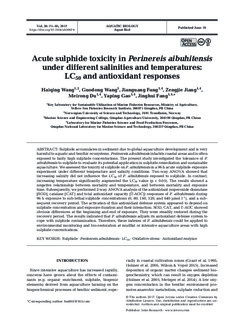| dc.contributor.author | Wang, Haiqing | |
| dc.contributor.author | Wang, Guodong | |
| dc.contributor.author | Fang, Jianguang | |
| dc.contributor.author | Jiang, Zengjie | |
| dc.contributor.author | Du, Meirong | |
| dc.contributor.author | Gao, Yaping | |
| dc.contributor.author | Fang, Jinghui | |
| dc.date.accessioned | 2018-06-25T11:17:48Z | |
| dc.date.available | 2018-06-25T11:17:48Z | |
| dc.date.created | 2017-10-12T13:50:34Z | |
| dc.date.issued | 2017 | |
| dc.identifier.citation | Aquatic Biology. 2017, 26, 75-85. | nb_NO |
| dc.identifier.issn | 1864-7790 | |
| dc.identifier.uri | http://hdl.handle.net/11250/2502836 | |
| dc.description.abstract | Sulphide accumulates in sediment due to global aquaculture development and is very harmful to aquatic and benthic ecosystems. Perinereis aibuhitensis inhabits coastal areas and is often exposed to fairly high sulphide concentrations. The present study investigated the tolerance of P. aibuhitensis to sulphide to evaluate its potential application in sulphide remediation and sustainable aquaculture. We assessed the toxicity of sulphide on P. aibuhitensis in a 96 h acute sulphide exposure experiment under different temperature and salinity conditions. Two-way ANOVA showed that increasing salinity did not influence the LC50 of P. aibuhitensis exposed to sulphide. In contrast, increasing temperature significantly augmented the LC50 value (p < 0.05). The results showed a negative relationship between mortality and temperature, and between mortality and exposure time. Subsequently, we performed 2-way ANOVA analysis of the antioxidant (superoxide dismutase [SOD], catalase [CAT] and total antioxidant capacity [T-AOC]) responses of P. aibuhitensis during 96 h exposure to sub-lethal sulphide concentrations (0, 80, 160, 320, and 640 µmol l-1), and a subsequent recovery period. The activation of this antioxidant defense system appeared to depend on sulphide concentration and exposure duration and their interaction. SOD, CAT, and T‑AOC showed obvious differences at the beginning and end of exposure. They were steadily restored during the recovery period. The results indicated that P. aibuhitensis adjusts its antioxidant defense system to cope with sulphide contamination. Therefore, these indexes of P. aibuhitensis could be applied to environmental monitoring and bio-restoration at mudflat or intensive aquaculture areas with high sulphide concentrations. | nb_NO |
| dc.language.iso | eng | nb_NO |
| dc.publisher | Inter-Research | nb_NO |
| dc.rights | Navngivelse 4.0 Internasjonal | * |
| dc.rights.uri | http://creativecommons.org/licenses/by/4.0/deed.no | * |
| dc.title | Acute sulphide toxicity in Perinereis aibuhitensis under different salinities and temperatures: LC50 and antioxidant responses | nb_NO |
| dc.type | Journal article | nb_NO |
| dc.type | Peer reviewed | nb_NO |
| dc.description.version | publishedVersion | nb_NO |
| dc.source.pagenumber | 75-85 | nb_NO |
| dc.source.volume | 26 | nb_NO |
| dc.source.journal | Aquatic Biology | nb_NO |
| dc.identifier.doi | 10.3354/ab00674 | |
| dc.identifier.cristin | 1504174 | |
| dc.description.localcode | The authors 2017. Open Access under Creative Commons by Attribution Licence. Use, distribution and reproduction are un - restricted. Authors and original publication must be credited. | nb_NO |
| cristin.unitcode | 194,66,10,0 | |
| cristin.unitname | Institutt for biologi | |
| cristin.ispublished | true | |
| cristin.fulltext | original | |
| cristin.qualitycode | 1 | |

